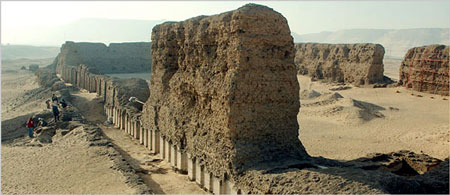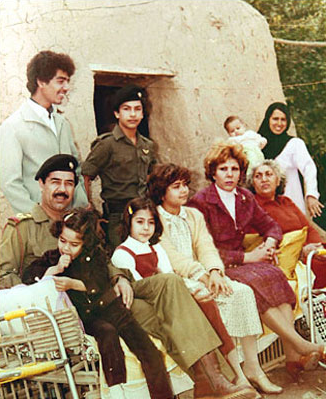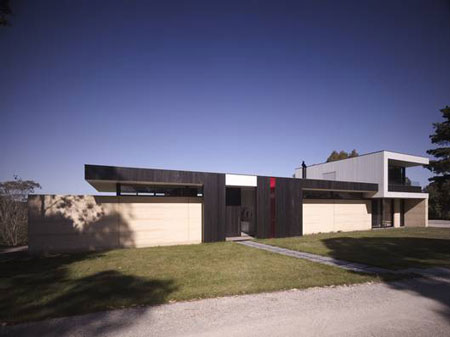Alternative Construction: Rammed Earth & Modular Contained Earth is a 3-hour interactive online course examines the systems and materials associated with alternative construction, including scenarios on the uses of rammed earth and modular contained earth. It discusses their histories, environmental impacts, and construction methods. This is part of a series of courses concerning Alternative Construction: Contemporary Natural Building Methods.
Shunet el-Zebib

photo: Institute of Fine Arts, N.Y.U./American Research Center in Egypt
Before the great pyramids, ancient Egyptian kings left less grandiose monuments to themselves: fortresslike sanctuaries enclosed by mud-brick walls. Inside these mortuary complexes, people presumably gathered to worship and perpetuate the memory of their departed ruler. The crumbling, almost vanished remains of such structures, archaeologists say, attest to the political hierarchy and religion of the newly unified Egyptian state, beginning more than 5,000 years ago.
Abari
![]()
Abari is a not-for-profit organization that examines, encourages, and celebrates the vernacular architectural tradition of Nepal. Much of that tradition includes the use of mud brick as seen traditionally in Eastern Kathmandu and in their recent Gobi Adobe project.
Saddam Hussein: 1937-2006

Saddam Hussein was born in a mud brick house to a family of sheep-herders in Tikrit, Iraq on April 28, 1937. He grew up in the town of Al Dawr, a mud brick town on the banks of the Tigris River.
Iraq is home to some of the most enduring wonders built in mud from the ancient world include the Ziggurat at Ur and the Ctesiphon Arch, the largest single-span vault of un-reinforced mud brick in the world. Adobe dwellings in Iraq date back as far as 8000 b.c. and the earliest known form molded adobe blocks are also in Iraq (5600 b.c).
The ruins of the ancient city of Babylon are also found in Iraq. Herodotus, the ancient Greek scholar, was so wowed that he wrote Babylon “surpasses in splendor any city in the known world.” Most of the splendor was made from mud and virtually all buildings in Babylon are constructed in mud brick. It was been an old Mesopotamian custom to impress the bricks, mainly those destined for public buildings, with the king’s seal.
Saddam Hussein wanted to be seen as the modern version of Nebuchadrezzar the Great, who ruled Bablyon in the 6th Century B.C.E. and is famous for bringing the city back to power and prosperity after a century of foreign rule by the Assyrian Empire. To make the connection clear, Saddam had a historically incorrect version of a 6th Century temple built atop the ruins of Nebuchadnezzar’s old temple. Walls more than 12 meters high and stamped with Saddam’s name replaced the stumpy mounds of biblical-age mud. Just as the ancient temple’s bricks bore the old king’s name, the new bricks said, “This was built by Saddam Hussein, son of Nebuchadnezzar, to glorify Iraq.” Following this, Saddam built a copy of a Sumerian ziggurat built on the mud brick ruins of the city. Modern archeologists frowned heavily upon him for building on top of old ruins.
Saddam Hussien was executed today, December 30, 2006 for crimes against humanity.
Trilogy
Red Hill Residence

The Red Hill Residence designed by CHRISTOPHERCHRIS PTY LTD ARCHITECTURE was constructed in Mornington Peninsula, Australia. More images of the project can be found at Arkinetia where they write, the house is “constructed primarily from locally sourced rammed earth and ship lapped cedar panelling, the house is sited across the ridge of the property. The elemental form of the building is enhanced by the contrasting and intersecting selection of material, textures and colours, threaded together by the linear rammed earth wall.”
5o Seminario Arquitectura de Terra em Portugal
The Fifth Annual Conference of Earthen Architecture in Portugal will take place October 10-13, 2007 at the University de Aveiro in Portugal. For more information, download the conference brief (Portugues Language).
2007 International Symposium on Earthen Structures
The 2007 International Symposium on Earthen Structures will take place August 22-24, 2007 in Bangalore, India. The conference is jointly organized by the Department of Civil Engineering and Center for Sustainable Technologies at the Indian Institute of Science in Bangalore, India, the Department of Architecture and Civil Engineering at the University of Bath, U.K. and the Ecole Nationale des Travaux Publics de L’Etate, Lyon, France. Form more information, download the conference brief.
Experimental House

Tokyo-based Loco Architects won a national Japanese competition for a concept house which aims to impinge as little as possible on the environment. When the house becomes redundant, its rammed earth walls can simply be demolished and returned to the ground. The project received mention in the AR Awards for Emerging Architecture.
Terra 2008

Terra 2008, the 10th International Conference on the Study and Conservation of Earthen Architectural Heritage, will take place in Bamako, Mali from February 1-5, 2008. This is the 10th conference organized by the earthen architecture community under the aegis of ICOMOS since 1972, and the first to be held in Africa. The conference is expected to draw up to 300 specialists in the fields of conservation, anthropology, archaeology, architecture and engineering, scientific research, site management, and sustainable development of earthen architectural heritage. Organized by The Getty Conservation Institute and the Ministry of Culture of Mali in collaboration with Africa 2009 | CRATerre | ICOMOS South Africa | ICCROM | World Heritage Centre under the aegis of ICOMOS International Scientific Committee for Earthen Architectural Heritage
